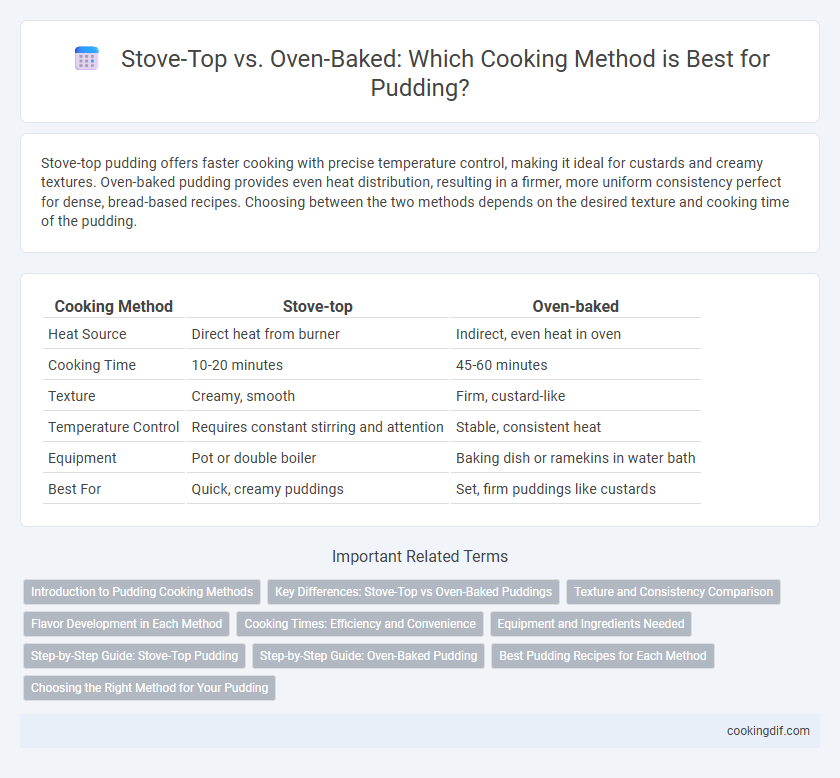Stove-top pudding offers faster cooking with precise temperature control, making it ideal for custards and creamy textures. Oven-baked pudding provides even heat distribution, resulting in a firmer, more uniform consistency perfect for dense, bread-based recipes. Choosing between the two methods depends on the desired texture and cooking time of the pudding.
Table of Comparison
| Cooking Method | Stove-top | Oven-baked |
|---|---|---|
| Heat Source | Direct heat from burner | Indirect, even heat in oven |
| Cooking Time | 10-20 minutes | 45-60 minutes |
| Texture | Creamy, smooth | Firm, custard-like |
| Temperature Control | Requires constant stirring and attention | Stable, consistent heat |
| Equipment | Pot or double boiler | Baking dish or ramekins in water bath |
| Best For | Quick, creamy puddings | Set, firm puddings like custards |
Introduction to Pudding Cooking Methods
Stove-top pudding cooking involves gently simmering the mixture over low heat, ensuring smooth texture and preventing curdling through constant stirring. Oven-baked puddings use a water bath technique to cook evenly, resulting in a firmer consistency with a delicate, custard-like finish. Choosing between stove-top and oven-baked methods depends on the desired pudding texture and complexity.
Key Differences: Stove-Top vs Oven-Baked Puddings
Stove-top puddings cook more quickly and allow for constant temperature control, resulting in a creamier texture due to gentle simmering. Oven-baked puddings require longer cooking times and even heat distribution, producing a firmer structure with a browned, caramelized crust. Stove-top methods are ideal for custards and soft puddings, while oven-baked techniques suit bread puddings and dense, layered desserts.
Texture and Consistency Comparison
Stove-top pudding offers a smoother, creamier texture due to constant stirring and controlled heat, preventing lumps and ensuring even cooking. Oven-baked pudding develops a firmer, custard-like consistency with a slightly caramelized top layer, ideal for firmer desserts. Choosing stove-top or oven-baked methods impacts moisture retention and mouthfeel, with stove-top favoring silkiness and oven-baked promoting a structured, denser pudding.
Flavor Development in Each Method
Stove-top pudding cooking enhances flavor development by allowing gentle, consistent heat that prevents scorching and promotes creamy texture with rich, infused taste. Oven-baked pudding, on the other hand, offers even heat distribution that caramelizes sugars on top, creating a deeper, toasted flavor profile. Each method influences moisture retention differently, with stove-top maintaining more moisture and oven-baking producing a firmer, concentrated flavor.
Cooking Times: Efficiency and Convenience
Stove-top pudding generally cooks faster, often requiring 20 to 30 minutes, offering efficiency for quick dessert preparation. Oven-baked pudding typically takes 45 to 60 minutes, providing a more even heat distribution that enhances texture but requires longer cooking time. Choosing between methods depends on convenience priorities: stove-top suits rapid cooking, while oven-baked favors depth of flavor and consistent results.
Equipment and Ingredients Needed
Stove-top pudding requires a heavy-bottomed saucepan and constant stirring to prevent burning, typically using milk, sugar, and cornstarch or eggs as thickening agents. Oven-baked pudding demands a heatproof dish and a water bath to ensure even cooking, often incorporating eggs and butter for richer texture. Both methods rely on precise temperature control and quality ingredients for optimal results.
Step-by-Step Guide: Stove-Top Pudding
Stove-top pudding involves heating a mixture of milk, sugar, and cornstarch gently while stirring continuously to avoid lumps and ensure a smooth, creamy texture. The mixture must be brought to a gentle boil, then simmered until it thickens, usually within 10-15 minutes, before removing from heat and cooling. This method allows for precise temperature control and quicker cooking compared to oven-baked pudding, which requires longer baking times and indirect heat.
Step-by-Step Guide: Oven-Baked Pudding
Oven-baked pudding offers a consistent and gentle cooking process by using a water bath, which helps achieve a creamy texture without scorching. Begin by preheating the oven to 325degF (163degC) and preparing a baking dish filled halfway with hot water to create the bain-marie. Pour the pudding mixture into ramekins or a baking dish, cover with foil, and bake for 45-60 minutes, checking for a set but slightly jiggly center before cooling.
Best Pudding Recipes for Each Method
Stove-top pudding recipes, such as classic vanilla or chocolate custards, excel in creamy texture and quick preparation, making them ideal for smooth, delicate desserts. Oven-baked puddings, like bread puddings or sticky toffee pudding, develop richer flavors and a dense, comforting consistency through slow, even baking. Selecting the best method depends on desired texture and flavor intensity, with stove-top favoring silky results and oven-baking enhancing depth and warmth.
Choosing the Right Method for Your Pudding
Stove-top pudding offers faster cooking with constant stirring, ideal for creamy, custard-like textures, while oven-baked pudding delivers even heat, perfect for denser, cake-like consistency. Consider the pudding type and desired texture when selecting the cooking method to ensure optimal flavor and structure. Stove-top is suited for delicate, smooth puddings, whereas oven-baking excels with rich, firm varieties.
Stove-top vs Oven-baked for cooking method Infographic

 cookingdif.com
cookingdif.com